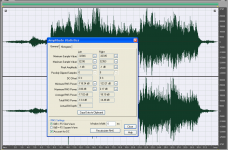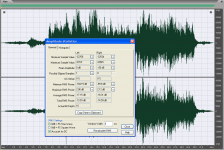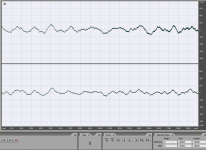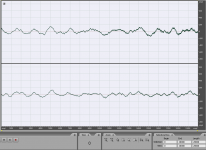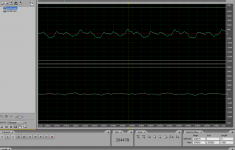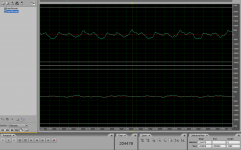BTW, this is the difference in that two files:
https://www.dropbox.com/s/cj7834fxl4jyjjo/mov4b-mov4a.wav?dl=0
https://www.dropbox.com/s/cj7834fxl4jyjjo/mov4b-mov4a.wav?dl=0
Hi Russell,
I can see from your profile that you are a recording engineer. Well, you have picked up the differences absolutely precisely.
mov4a = original wav data
mov4b = original wav to128kbps mp3 and transferred back to wav
Both files have same length and are matched both in amplitude and time. Good candidates for ABX. I am glad that at least someone prefers the original, for the reason that many times the degraded version won in my similar tests.
I can see from your profile that you are a recording engineer. Well, you have picked up the differences absolutely precisely.
mov4a = original wav data
mov4b = original wav to128kbps mp3 and transferred back to wav
Both files have same length and are matched both in amplitude and time. Good candidates for ABX. I am glad that at least someone prefers the original, for the reason that many times the degraded version won in my similar tests.
My idea of a better system is one that has less character of its own.
"Less characters". That assumed that "characters" are equivalent between one and another. How about "low THD and high TIM" versus "high THD and low TIM", which one has less characters?
I found that it is about priority, a proper/suitable way to prioritize "characters". Truer with far from perfect systems (like mine).
Hi Russell,
I can see from your profile that you are a recording engineer. Well, you have picked up the differences absolutely precisely.
mov4a = original wav data
mov4b = original wav to128kbps mp3 and transferred back to wav
Both files have same length and are matched both in amplitude and time. Good candidates for ABX. I am glad that at least someone prefers the original, for the reason that many times the degraded version won in my similar tests.
Because lossy codecs always change the waveshape, you must not change the levels of the files after coding. This also means that clipping can occur with lossy codecs, when the original file is not clipping. So just make sure the start and end points are the same and its good for ABXing. If for some idiotic reason the lossy codec changes the RMS level of the files, reject the codec.
If the original file is clipping, witch happens all to often these day's, then lossy codecs will have more difficulty coding the file without audible artefacts.
ABX can only test for audible differences, nothing more!
For preference tests you need ABC/HR.
Its very easy to cheat on the test you presented, just put the files through a spectrum analyser and see what file has its high frequency's cutoff.
All that said: We need more tests like this.
Because lossy codecs always change the waveshape, you must not change the levels of the files after coding.
I have not. Please feel free to check both files. I prefer real work above assumptions.
The levels were unified for the difference file only.
Regarding ABX, mov4a and mov4b can be reliably distinguished in ABX - depends on good ears and good system used.
TIM is not an issue anymore. It was, 40 years ago.
Not to you and probably most of the people here, but I wouldn't be so sure of the industry at large.
Certainly much less of a problem than it used to be, but I still see and hear some really wierd amps around, with 80+ dB of global NFB, VERY narrow open loop power bandwidths and often way too overcompensated.
mov4a and mov4b amplitude statistics, no amplitude manipulation has been used.
"Matched" I meant that there is no special difference in volume setting, sorry for possible confusion. Amplitude statistics should make it clear rather than words. Words are a subject of nit picking.
"Matched" I meant that there is no special difference in volume setting, sorry for possible confusion. Amplitude statistics should make it clear rather than words. Words are a subject of nit picking.
Attachments
Last edited:
"Less characters". That assumed that "characters" are equivalent between one and another. How about "low THD and high TIM" versus "high THD and low TIM", which one has less characters?
I found that it is about priority, a proper/suitable way to prioritize "characters". Truer with far from perfect systems (like mine).
Not necessarily equivalent, just distinguishable one form the other.
And sometimes, this difference is hard to hear, other times easy to pick out.
I prefer the one named mov4a. "mov4b" sounds distinctly inferior as to the reproduction of the strings in the opening (from 0.01 to 0.06) and coarser in general. In "mov4a" the strings sound more realistic with a distinctly finer texture - silk vs. cotton, and cheap cotton at that.
Sure hope they're not the same and I'm exposing myself as a victim of auto-suggestion!
By the way, I'm judging this on my newish Beyerdynamic DT 1350 headphones, since the family's asleep and I can't use speakers.
Spot on, Russ.
My idea of a better system is one that has less character of its own. The less speaker or amplifier you hear, the more you can hear the recording, for better or worse. To me this makes listening not only more informative when judging my own recordings when mixing or mastering mine or others, it is more fun when listing to recordings in general.
If a playback system has a strong "personality", it imposes that upon anything it is attempting to reproduce, the sameness making the process increasingly boring and ultimately leading to "upgrade-itis".
In a much misused word - transparency or neutrality.
In my view, that starts with the speakers. We have come a long way with speakers since the old days, much more so than with anything else. Back way then, a speaker with a THD of say 0.2% 50-20.000 Hz was a dream, today it's reality.
The only aspect of speakers, as far as I know, we have not made much progress with is efficiency. Admittedly, these days it's not easy to find speakers with an efficiency of say 86 dB/2,83V/1m, most have gone up to 89+ dB, but I still feel that is a relatively small step.
I have not. Please feel free to check both files. I prefer real work above assumptions.
The levels were unified for the difference file only.
Regarding ABX, mov4a and mov4b can be reliably distinguished in ABX - depends on good ears and good system used.
My reply wasn't a criticism, just general remarks.
Most people can positively ABX 128kb/sec mp3, nothing special about that.
Edit: What is kind of mind boggling about this, is that we can take away more than 90% of the information in the sound file and still have decent sound quality.
Last edited:
All that said: We need more tests like this.
There have been numerous ones posted here, one of the most notorious being interconnect comparisons between copper, a banana, a potato, and mud. Unfortunately, they tend to bring out the file analysis creativity in many...
Edit: What is kind of mind boggling about this, is that we can take away more than 90% of the information in the sound file and still have decent sound quality.
Yes, but only in case you do not have an opportunity to make a comparison with an original file on a good sound system. I agree with you that good = transparent and transparent means almost nothing add or subtracted to/from original signal.
I agree with you that good = transparent and transparent means almost nothing add or subtracted to/from original signal.
If you add in the qualifier "audibly" to "transparent" and "audibly" to "add(ed) or subtracted", that would also be my definition.
Why do some people find it so difficult to clearly define their terms?
Because "audibly" is strongly subjective and depends both on hearing abilities and quality of the sound system used. So, we may agree partially 
There are several websites that provide blind audio tests like wav/mp3, 16bit/8bit etc. I have big troubles with most of them, for the reason they use inadequate and low quality recordings for comparisons. IMO it is a kind of manipulation to show that everything sounds same, more, probably a kind of marketing support to lossy compression music. If I use a good recording like the one posted today, it is possible to tell the difference. If I used the originally compromised files, it would not be possible. That's my big problem with on-line pseudo-scientific tests that act like scientific ones.
There are several websites that provide blind audio tests like wav/mp3, 16bit/8bit etc. I have big troubles with most of them, for the reason they use inadequate and low quality recordings for comparisons. IMO it is a kind of manipulation to show that everything sounds same, more, probably a kind of marketing support to lossy compression music. If I use a good recording like the one posted today, it is possible to tell the difference. If I used the originally compromised files, it would not be possible. That's my big problem with on-line pseudo-scientific tests that act like scientific ones.
Because "audibly" is strongly subjective and depends both on hearing abilities and quality of the sound system used. So, we may agree partially
There are several websites that provide blind audio tests like wav/mp3, 16bit/8bit etc. I have big troubles with most of them, for the reason they use inadequate and low quality recordings for comparisons. IMO it is a kind of manipulation to show that everything sounds same, more, probably a kind of marketing support to lossy compression music. If I use a good recording like the one posted today, it is possible to tell the difference. If I used the originally compromised files, it would not be possible. That's my big problem with on-line pseudo-scientific tests that act like scientific ones.
Audibility is perfectly defined, because either you hear it or you don't.
Most people I know of, that can positively ABX 320kb/sec mp3 files do that on artificial recordings with unnatural high frequency content. It is also not unusual that these people use very cheap headphones and have severe hearing damage.
One criticism on the files you posted: The start and endpoints must be exactly the same, this is not the case. Most codecs add silence before and after the sound file. This can cause a false positive.
One criticism on the files you posted: The start and endpoints must be exactly the same, this is not the case. Most codecs add silence before and after the sound file. This can cause a false positive.
Not sure if I understand you. To me, the files start point is the same. How do you define or find the "start point"?
Attachments
- Status
- Not open for further replies.
- Home
- Member Areas
- The Lounge
- Sound Quality Vs. Measurements
